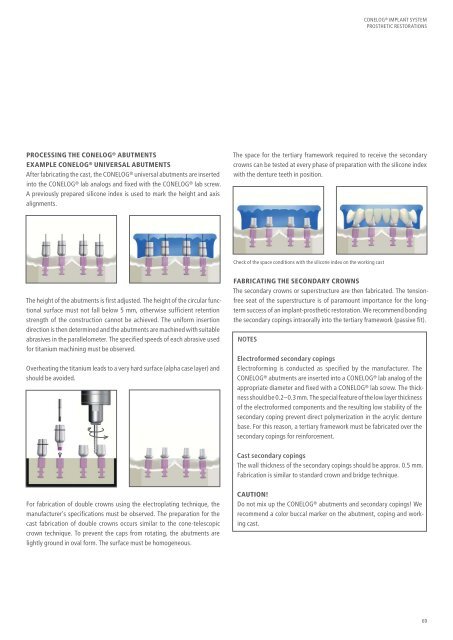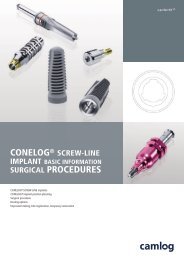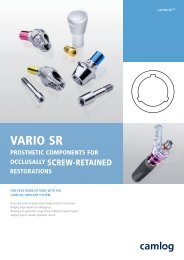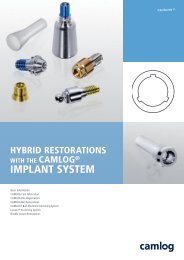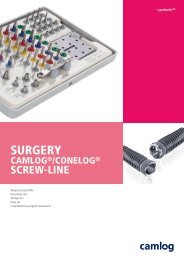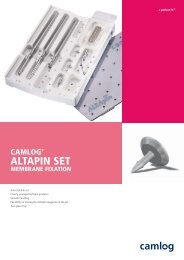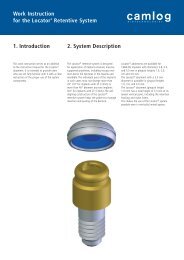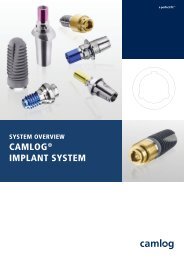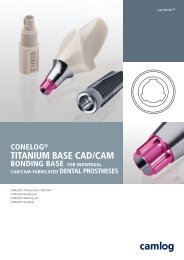CONELOG® Implant System Prosthetic Restorations - Camlog
CONELOG® Implant System Prosthetic Restorations - Camlog
CONELOG® Implant System Prosthetic Restorations - Camlog
Create successful ePaper yourself
Turn your PDF publications into a flip-book with our unique Google optimized e-Paper software.
PROCESSING THE CONELOG ® ABUTMENTS<br />
EXAMPLE CONELOG ® UNIVERSAL ABUTMENTS<br />
After fabricating the cast, the CONELOG ® universal abutments are inserted<br />
into the CONELOG ® lab analogs and fixed with the CONELOG ® lab screw.<br />
A previously prepared silicone index is used to mark the height and axis<br />
alignments.<br />
The height of the abutments is first adjusted. The height of the circular functional<br />
surface must not fall below 5 mm, otherwise sufficient retention<br />
strength of the construction cannot be achieved. The uniform insertion<br />
direction is then determined and the abutments are machined with suitable<br />
abrasives in the parallelometer. The specified speeds of each abrasive used<br />
for titanium machining must be observed.<br />
Overheating the titanium leads to a very hard surface (alpha case layer) and<br />
should be avoided.<br />
For fabrication of double crowns using the electroplating technique, the<br />
manufacturer's specifications must be observed. The preparation for the<br />
cast fabrication of double crowns occurs similar to the cone-telescopic<br />
crown technique. To prevent the caps from rotating, the abutments are<br />
lightly ground in oval form. The surface must be homogeneous.<br />
CONELOG ® IMPLANT SYSTEM<br />
PROSTHETIC RESTORATIONS<br />
The space for the tertiary framework required to receive the secondary<br />
crowns can be tested at every phase of preparation with the silicone index<br />
with the denture teeth in position.<br />
Check of the space conditions with the silicone index on the working cast<br />
FABRICATING THE SECONDARY CROWNS<br />
The secondary crowns or superstructure are then fabricated. The tensionfree<br />
seat of the superstructure is of paramount importance for the longterm<br />
success of an implant-prosthetic restoration. We recommend bonding<br />
the secondary copings intraorally into the tertiary framework (passive fit).<br />
NOTES<br />
Electroformed secondary copings<br />
Electroforming is conducted as specified by the manufacturer. The<br />
CONELOG ® abutments are inserted into a CONELOG ® lab analog of the<br />
appropriate diameter and fixed with a CONELOG ® lab screw. The thickness<br />
should be 0.2–0.3 mm. The special feature of the low layer thickness<br />
of the electroformed components and the resulting low stability of the<br />
secondary coping prevent direct polymerization in the acrylic denture<br />
base. For this reason, a tertiary framework must be fabricated over the<br />
secondary copings for reinforcement.<br />
Cast secondary copings<br />
The wall thickness of the secondary copings should be approx. 0.5 mm.<br />
Fabrication is similar to standard crown and bridge technique.<br />
CAUTION!<br />
Do not mix up the CONELOG ® abutments and secondary copings! We<br />
recommend a color buccal marker on the abutment, coping and working<br />
cast.<br />
69


